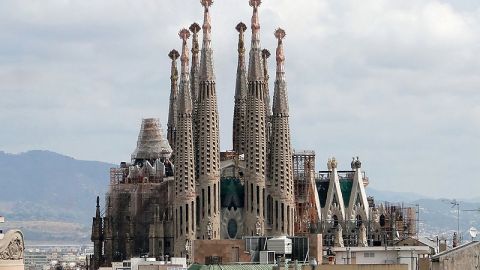Getting to Yes: Pope Consecrates Gaudi’s Sagrada Familia

On November 7th, Pope Benedict XVIconsecratedAntoni Gaudí’s weirdly wonderful masterpiece of religious architecture, the Sagrada Família (shown above). The Catholic Church tends to distrust anything modern these days, so seeing it accept one of the earliest works of modern 20th century architecture seems a little out of character. Some hope that this marks a change in the persistent “no” of the current Pope to a more hopeful, accepting “yes.” Everything about the Sagrada Família screams “yes” to the exuberance of life and overflowing imagination. Getting to that “yes,” and getting to the Papal “yes,” remains an interesting story and a work in progress.
Gaudi began working on Sagrada Família, which means Holy Family in Spanish, in 1883, taking over from architect Francisco de Paula del Villar, who had begun designing the year before. Gaudi changed Villar’s designs almost completely and continued to work on the basilica for the rest of his life. Although Villar imagined a Gothic church and Gaudi built upon that Gothic idea, Sagrada Família is Gothic grown up—literally grown up out of the earth. That organic element of Gaudi’s vision earns him both derision and praise, depending on your taste in religious art and architecture. “Those who look for the laws of Nature as a support for their new works,” Gaudi once said, “collaborate with the Creator.” With God as his architectural copilot, Gaudi’s flights of sculptural fancy knew no bounds.
Sadly, Gaudi’s personal life collapsed as his masterpiece slowly rose. A beloved niece died in 1912. Francesc Berenguer Mestres, one of Gaudi’s closest collaborators, died in 1914. The death of Eusebi Güell, Gaudi’s main patron, in 1918 served as a final blow to his psyche. After 1918, Gaudi worked exclusively on Sagrada Família and even lived in the recently completed crypt. The architect immersed himself into the project so devoutly that he became an eccentric recluse. On June 7, 1926, a tram car struck Gaudi as he crossed the street. Cab drivers failed to recognize the artist and refused to take the strange old man dressed in rags to the hospital. Three days later, Gaudi died from his injuries. Admirers buried Gaudi in Sagrada Família, the one place on earth he wanted to be.
Because of that tragic end and his fanatical devotion to Sagrada Família, Gaudi has become a quasi-religious figure in Spain. Advocates hope to one day obtain sainthood for the architect and believe that the recent consecration marks the initial step in Vatican acceptance of the idea. Something in the Spanish soil seems to give flower to powerful religious visionaries, from Saint Teresa of Ávila and Saint John of the Cross to Gaudi and even the Surrealist Salvador Dali. The official church embraces such powerful visionaries slowly, usually fearing their capacity to critique the status quo as much as their ability to inspire fiery religious fervor. Gaudi may still be too hot to handle for some conservative Catholic minds.
Gaudi and Pope Benedict XVI make strange bedfellows. During the consecration ceremony, approximately 200 gay protestors staged a “kiss-in,” holding their liplock for 5 minutes in opposition to the Catholic Church’s stance on homosexuality. The Pope’s consecration ceremony homily stressed traditional family values in the face of the threat of divorce, same-sex marriage, and abortion. Standing in a church named for the Holy Family, Pope Benedict felt he was on firm ground to make such statements. And, yet, Gaudi’s strange sanctified structure seems an odd place for conservative statements. Gaudi himself may have agreed with Pope Benedict’s words, but Gaudi’s architecture says something different. A man of his time and place, Gaudi supported his church unquestioningly, but the challenge his architectural vision poses to conventional thinking has outlasted his words. I’d like to think that Gaudi—the architect of “yes”—would have sided with the “kiss-in” protestors, if he were alive today. Why should you ever say “no” to life, to love? I can hear Gaudi saying. Although Gaudi remained sexually celibate to his dying day, I can imagine him cheering on the passion of any group that loves against the odds.
Anarchists destroyed Gaudi’s original plans for Sagrada Família in 1938 during the Spanish Civil War. Since then, followers have more or less guessed at what Gaudi intended. They hope to complete the basilica, which was only about 15% finished at Gaudi’s death, by 2026 to commemorate the centennial of Gaudi’s death. The outward façade of Sagrada Família is pure Gaudi, but almost everything else behind it is not—except in the sense that it grew in the spirit of Gaudi, the spirit of “yes.” If you look at it in that way, Sagrada Família remains 100% Gaudi, even if realized by other hands and minds. Maybe when that final piece falls into place in 2026, the Catholic Church itself will have embraced the spirit of Gaudi and said “yes” to modern life as well as modern architecture.





